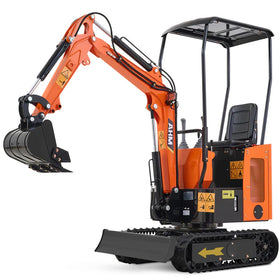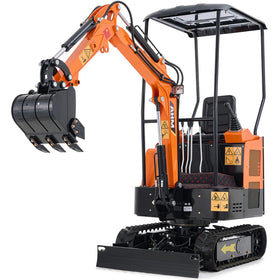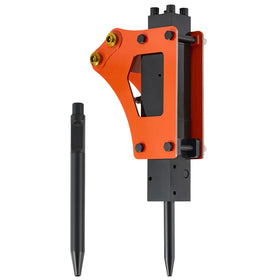The use of a mini excavator in muddy or wet conditions is challenging. Slippery surfaces, waterlogged soil, and soft terrain can result in instability and potential damage to the equipment, especially the mini excavator tracks. In this guide, we focus on safe operation practices for mini excavators working in muddy and watery environments.
Essential Components to Monitor for Mini Excavators in Muddy and Watery Conditions
When working in mud or in shallow water, there are several components of a mini excavator you need to pay extra attention to prevent breakdowns and ensure safe operation:
-
Undercarriage — The undercarriage will collect the most mud and debris. Regular cleaning prevents buildup that can strain rollers and sprockets.
-
Hydraulic system — Seals and hoses are vulnerable to water and grit. It is advisable to check for lubrication leaks and to wipe off the fittings after exposure.
-
Electrical connections — Water intrusion can lead to short circuits; inspect connectors and keep them dry whenever possible.
-
Mini Excavator Tracks and Track Tensioner Assembly — The tracks provide stability on slippy surfaces. Ensuring tracks are clean, free of packed mud, and properly tensioned by maintaining the track tensioner assembly reduces the risk of slippage, derailment, and extends component life.
Mini Excavator Mud Escaping Techniques
Common Mud Entrapment Scenarios
Mini excavators often encounter two types of entrapment: single-track and double-track. Recognizing the type of entrapment helps determine the safest and fastest way to recover.
Single-Track Entrapment (One-Track Stuck)
1.Check if just one of the tracks is trapped. If so, proceed to the next step. If not, see the below for both tracks’ entrapment.
2. Set the angle between the arm and boom to somewhere between 90° and 110°.
3. Retract the bucket, lay the bottom against sturdy ground, and raise the bucket to raise the whole excavator up.
4. Lay a sturdy plank under the raised track. Raise the bucket and move out of the entrapment.

Double-Track Entrapment (Both Tracks Stuck)
1. Repeat steps 1–3 in One-Track Entrapment.
2. Lay two sturdy planks or similar-shaped objects under the lifted tracks, ensuring the planks are inserted into the end of the tracks.
3. Use the bucket as a leverage point while traveling out of the entrapment.

Additional Tips
- Avoid rapid acceleration, which can worsen entrapment.
- Keep tracks clean of mud and debris whenever possible to maintain traction.
Water Safety Guidelines
- NEVER submerge the cab in water. This will immerse the radiator and burn it. If you must operate in water, ensure the water doesn’t cover the whole track. Apply sufficient lubricating oil for any parts that have been underwater when on land.

- ONLY wade through water when you know it cannot compromise the safe operation of the excavator and your personal safety. Drive through at a stable, slow speed.

Routine Maintenance and Inspections for Mini Excavator Tracks
Track Condition Monitoring
Examine the rubber or metal sections of the mini excavator tracks for any uneven wear or damage. Identify the early stages of tensioner assembly issues, such as excessive slack in the track, or an uneven track, to prevent derailment.
Lubrication Best Practices
Use suitable lubricants to protect the moving parts in the tensioner assembly, as well as the actual track rollers. Good practice is to reapply lubrication after operating in muddy or wet conditions to avoid corrosion and wear.
Hardware Tightness Checks
Besides checking the bolts and nuts' tightness, check for tightness on the washers, pins, and all hardware that secures the track system and the tensioner assembly. If there's loose or missing components, it can lead to faster wear or a breakdown of hardware.
Environmental Adaptation Maintenance
Adapt the frequency and process of maintenance to suit your working conditions. In continually muddy or wet environments, you would increase the frequency of cleaning and lubricating the mini excavator tracks, as well as the tensioner assembly, keeping it clean reduces wear.
Detailed Record Keeping
Maintain thorough logs of all maintenance activities, particularly inspections, adjustments, and parts replacements related to mini excavator tracks and track tensioner assembly. This aids in tracking component lifespan and planning preventive maintenance.
Summary
When operating in muddy and watery conditions, it is important to carefully monitor the mini excavator tracks and track tensioner assembly to ensure safe operation and productivity. With a bit of preventative maintenance, regular inspections, and careful operation, the performance and life of the equipment can be maximized. Always place safety first and use all manufacturer recommendations to protect the operator and equipment.
Frequently Asked Questions (FAQ)
Q: How often should the track tensioner assembly be maintained?
A: Inspect before and after each operation in challenging conditions and follow the manufacturer’s recommended maintenance schedule.
Q: How can I quickly escape from a mud entrapment?
A: Identify whether it’s single- or double-track entrapment, use the bucket for leverage, and carefully maneuver without overstressing the tracks or tensioner assembly.
Q: How do I know when mini excavator tracks need replacement?
A: Signs include excessive wear, cracks, or reduced traction even after cleaning and proper tensioning.
Q: What are the signs of a failing track tensioner assembly?
A: Loosened tracks, sagging, unusual noises, or uneven track wear indicate the assembly may need adjustment or replacement.







